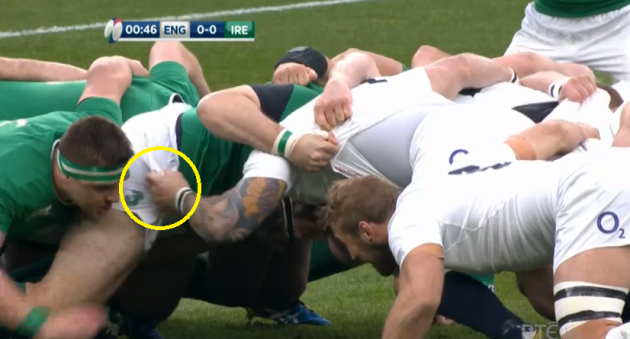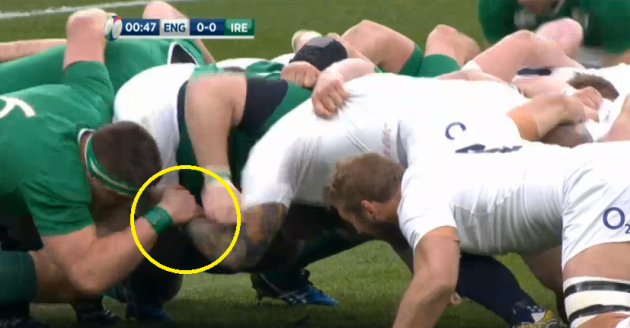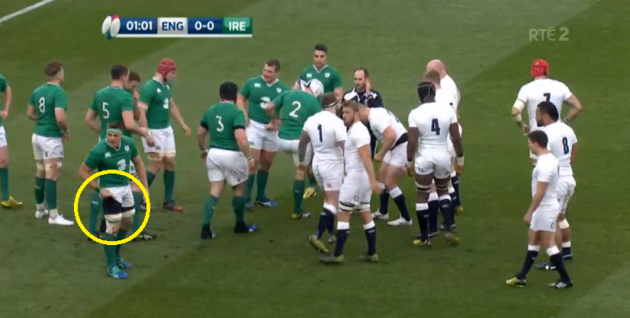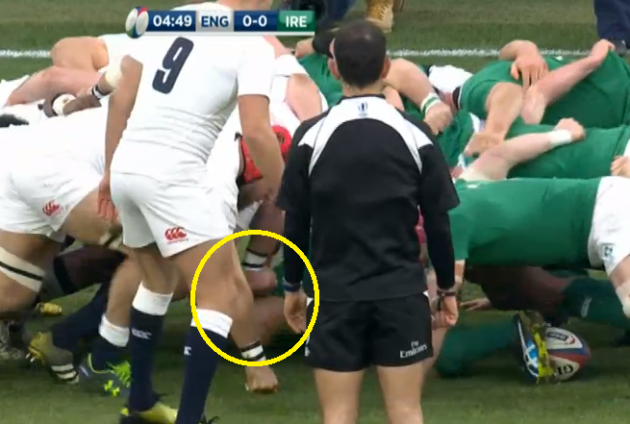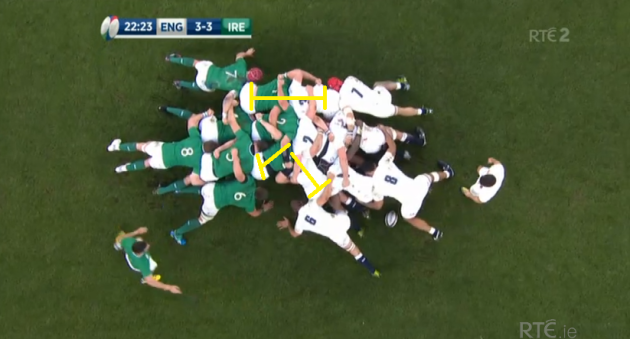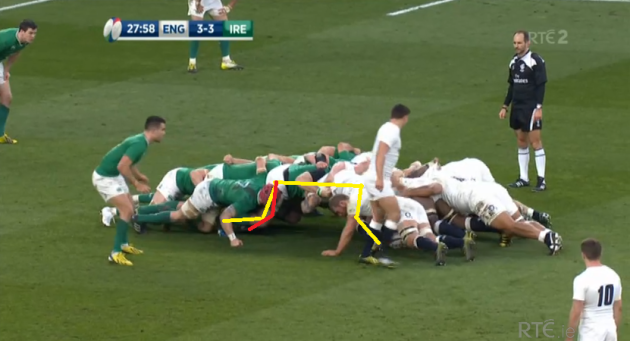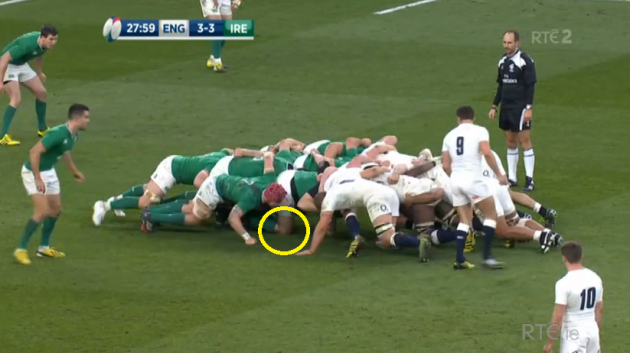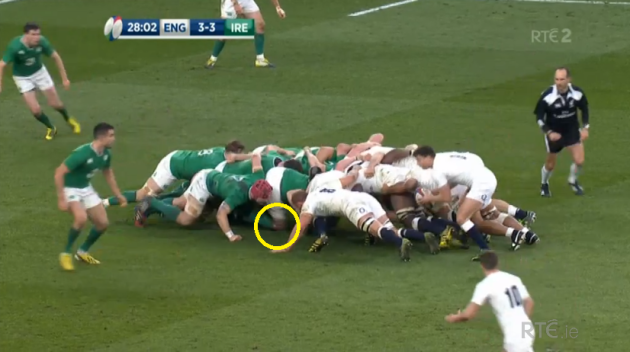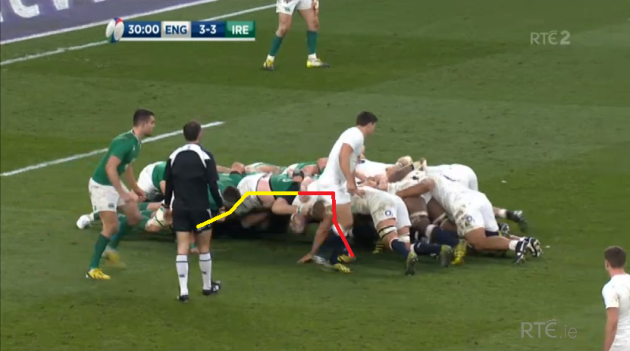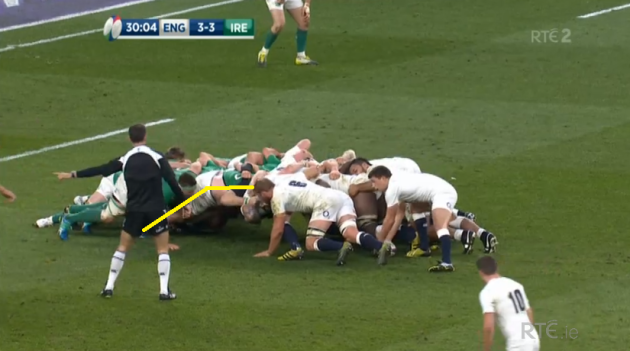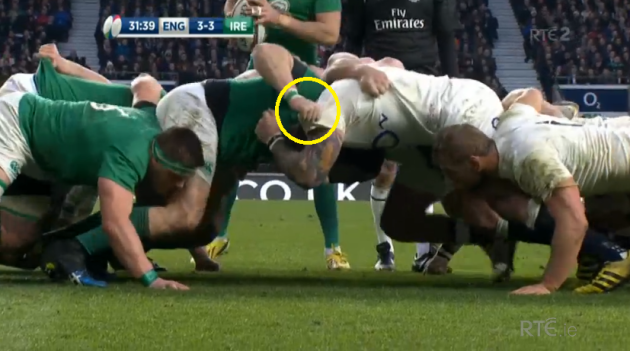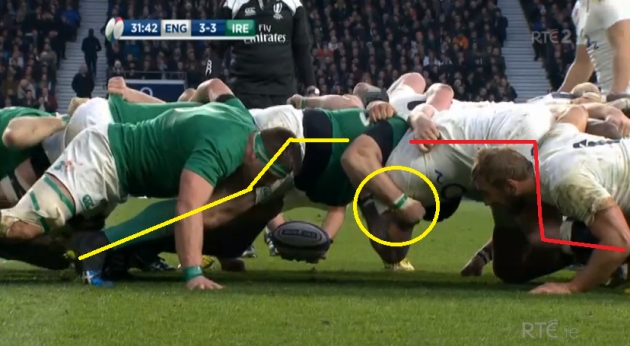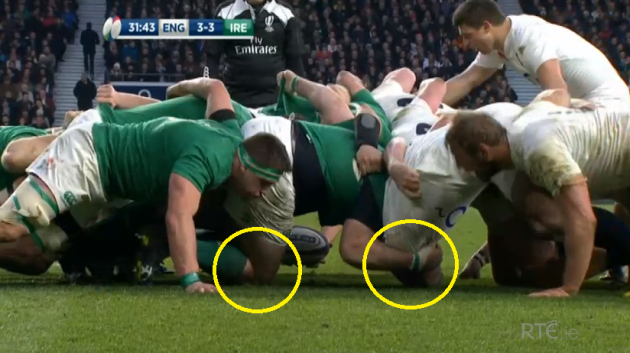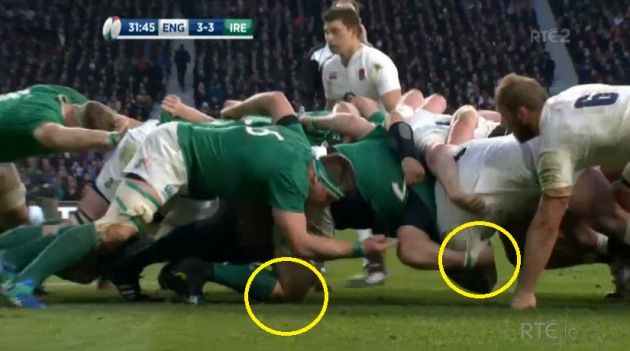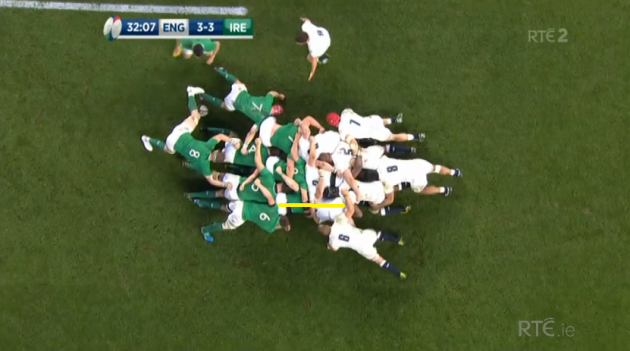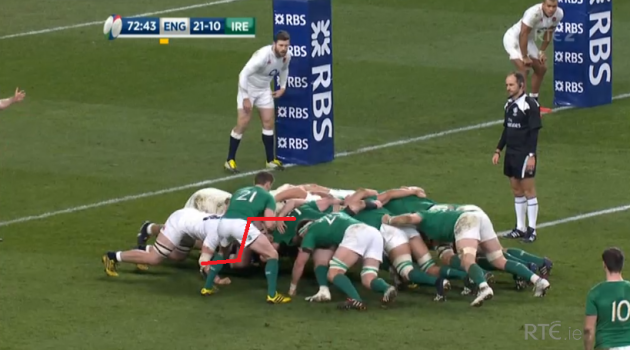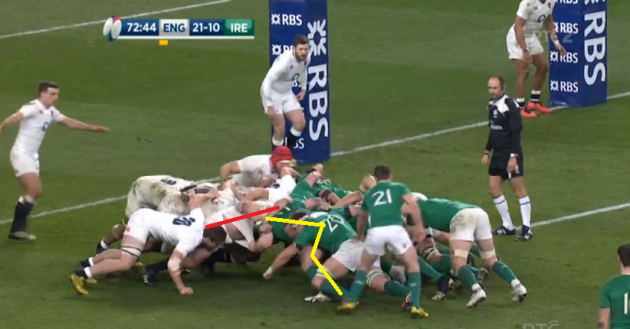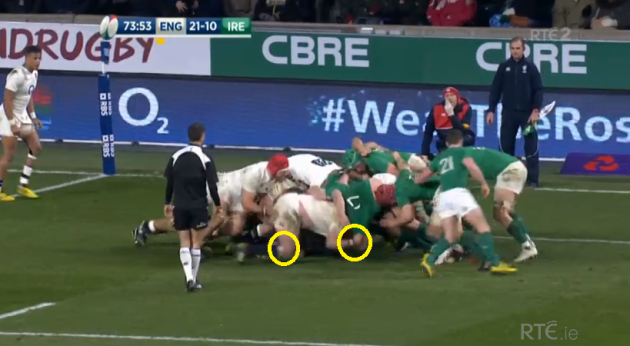AT TIMES, EVEN when you can see exactly what’s happening in the scrum, it’s hard to know who to penalise.
When more than one team is trying to cod you at the same time, it leaves referees in a very difficult situation.
After Ireland’s scrum capitulated in the second half of their defeat to France last time out, Saturday’s game at Twickenham was a much more even affair. On the whole, England probably shaded it, but momentum swung back and forth and Ireland were far sturdier when they packed down than in previous games.
I’ve been heavily critical of Romain Poite as a scrum referee for a long time, but I have sympathy with him after this game. It highlighted further the glaring need referees have for additional help refereeing the scrum, and how an assistant referee alone isn’t enough to properly assist it.
The first scrum of the day was eye-opening; a fantastic example of everything that’s wrong with the scrum in the modern game. It was cheating, followed by counter-cheating.
After a reset, Ireland eventually got the ball in and out, but the original scrum was fascinating. Both England and Ireland could have conceded penalties, but with the referee watching the other side, and the touch judge 20 metres away, both sides got away with it.
England’s Joe Marler was the first man to chance his arm, binding onto the shorts of Mike Ross. The reason props sometimes do this is to then try pull the opponent’s hips out, before angling the drive across their body.
It’s likely CJ Stander was expecting this, because he reacted immediately.
Spotting Marler had switched his bind onto the shorts of Ross, Stander grabs the Englishman’s arm, and pulls it down to the ground, causing the scrum to collapse.
It’s a very dangerous thing to do, with the scrum guaranteed to drop, and it leaves players unable to break their own fall. With Poite on the other side, his assistant offered no help and a reset was called.
Marler wasn’t happy; he and Stander exchanged some verbals immediately after, and as the players prepared to pack down for the reset, we could see both sides trying to get their message across to Frenchman Alex Ruiz, who was patrolling the near touchline.
First, Stander asked him to watch out for the bind on the shorts…
Before Chris Robshaw gave his tuppence worth, telling Ruiz to watch for Stander pulling at his prop’s bind…
On the reset, Marler’s bind was perfect, Stander kept his hands where they should be, and Ireland got the ball in and out without issue.
What that failed initial scrum showed us however is that there is so much going on for just one person to be patrolling. Obviously Marler’s infringement came first, but Stander’s was far greater. Which do you prioritise?
Things were far less ambiguous on the second scrum of the day, however. Last week, we wrote at length about Dan Cole’s tendency to bind on the arm and pull his loosehead to the ground, and it took just four minutes for him to do it again.
This time, however, Poite was beside it and spotted it.
It’s difficult to see on the TV replays, with Poite blocking the scrum, but as it hits the ground, we can just about see how Cole is gripping the tricep of Jack McGrath as he reaches the deck.
Given Poite was directly beside the incident, and Cole’s previous with this kind of tactic, we’d be inclined to give the referee the benefit of the doubt.
England hit back with a penalty of their own, and it looked to be a harsh decision against Ireland.
During the World Cup, Marler’s tendency to drive at an angle was exposed regularly, but since the change-up in the English coaching staff, it’s something he seems to do less and less.
However, like all loosehead props, he is still prone to the occasional angled drive, and it helped milk him a penalty on the third scrum of the day.
We can see below how both he and Ross are facing into the scrum, but the key to determining who initiated the angle is often down to the direction their hips are facing.
With Marler, his hips are facing in the same direction as his body. Essentially, he’s controlling the direction of the drive.
And when we watch the scrum back in full, we can really see the power Marler puts into the angle. Just look at his left leg, as he steps out and drives off across Ross. Again, Poite can only watch one side of the scrum.
What’s most annoying about seeing someone like Marler angling into a scrum is that when he wants to scrummage legally, he’s almost immovable.
He had Ross under a lot of pressure close to the Irish line, and on another day, the Ireland tighthead could have been penalised for dropping to his knees.
In the initial set up, we can see how Ross probably has his feet a fraction too far behind his body in preparation for the shove. The red line is a rough guide to where his legs should be, giving him more balance.
The positioning of his feet becomes important when Marler begins to drive fully as Ross slips to his knees.
He manages to get back to his feet, but just as England remove the ball from the scrum, we can see how he’s dropped again.
Some may point out that Marler appears to be angled into the scrums above and below, but it’s really just a result of correcting his balance, after Ross has fallen.
In the next scrum we can again see just how far Ross is locking out his legs, to stave off the push from a straight and square Marler.
And when Ben Youngs is removing the ball from the scrum, Ross is now completely locked out.
After a long period of pressure, there is huge relief for Ireland after they win a penalty at the next scrum of the day, close to their try line. However, it’ a very lucky escape, and a penalty they never should have been awarded.
It starts with Ross taking an initial bind on the shoulder of Marler…
Much like Cole in that earlier scrum, Ross uses the short bind to pull Marler down to the ground. We can also see how far his legs are locked out in comparison to Marler, which has an impact on his maneuverability.
As a result, Ross drops to his knee, and pulls Marler with him.
He gets back to his feet, but again he falls to his knee. However, it’s actually Marler who is penalised for collapsing. It’s hard to tell whether Poite guessed, or he was given a tip by his touch judge, but it’s probably the worst call of the day at the scrum.
At the time, I saw an argument that Marler had been angling in, but when we look at the overhead shot, that’s certainly not the case.
After only two of the game’s first 11 scrums needed resets, it didn’t come as a shock that when Ireland were close to the English line with nine minutes to play and England down to 14 players, we needed three attempts at the scrum to get the ball in and out.
The first time, Cole collapsed immediately to eat up some clock, before the second attempt was abandoned after the English front row deliberately slowed down the engagement process.
On the third go, Cole knew he had nothing to lose, and tried to bore in on the Irish front row.
We can see below how the front rows line up. Here, Cole is straight and square to Cian Healy.
But we can see how he takes a large step to his right and then pushes off his right foot to attack Ireland at the angle.
When we watch the scrum back in full, we can see just how exaggerated his step to the right, and the resulting push is. Luckily, Ireland get the ball in and out before Cole’s drive has a meaningful impact.
The only scrum of the day lost against the head came five minutes from time, and it all but ended Ireland’s chances of a comeback.
It was actually an excellent call from Poite, who was on the other side of the scrum, especially because from what we can see, he isn’t given any kind of signal from his assistant referee.
At first, I was baffled by the call. From the view we had, and directly in front of Poite, Cole had dropped his knee and elbow to the ground, while Healy remained on his feet, with his bind also staying above the pitch.
However, as the players walk away, Poite signals that it was 18 green that he was penalising for collapsing, and the aerial shot eventually solved the mystery for us.
We can see how Nathan White caves in under pressure from Mako Vunipola, and that the domino effect from that collapse is what causes Cole to drop. A good call.
Unfortunately, Vunipola never got the credit. His teammates swarmed Cole, slapping his back and patting his head, while poor Mako walked away alone.
Cole did, however, deserve some slaps on the back for another strong 80-minute performance. He’s now played all but 10 minutes of England’s campaign to date, completing the full 80 against both Ireland and Scotland.
Had England not been 20-odd points clear with 10 minutes left against Italy, chances are he’d have seen that game out as well. Still, 230 out of 240 minutes is almost unheard of for a modern international tighthead.
It was a much more assured Irish scrummaging performance than the capitulation against Paris, and while Ross had a couple of difficult moments against Marler, he locked things out when needed.
I’ve barely mentioned Jack McGrath’s name in this piece, and it’s testament to how he played in the scrums on Saturday. Solid, reliable and assured.
Against Italy, expect himself and Ross to assume control.
The42 Six Nations Show / SoundCloud
